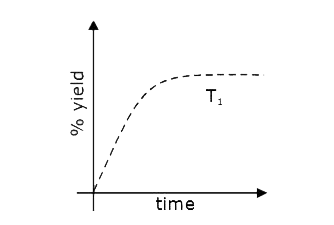Consider the following reactions .In which case the formation of product is favoured by decreasing pressure?
(1)CO2(g)+C(s)⇔2CO(g),ΔH∘=+172.5Kj
(2)N2(g)+3H2(g)⇔2NH3(g)⇔2NH3(g),ΔH∘=−91.8KJ
(3) N2(g)+O2(g)⇔2NO(g),ΔH∘=181KJ
(4) 2H2O(g)⇔2H2(g)+O2(g),ΔH∘=484.6KJSolution in Telugu
2,3
3,4
2,4
1,4
The correct Answer is:d
Step by step video & image solution for Consider the following reactions .In which case the formation of product is favoured by decreasing pressure? (1)CO_(2)(g)+C(s)hArr2CO(g),DeltaH^(@)=+172.5Kj (2)N_(2)(g)+3H_(2)(g)hArr2NH_(3)(g) hArr2NH_(3)(g),DeltaH^(@)=-91.8KJ (3) N_(2)(g)+O_(2)(g)hArr2NO(g),DeltaH^(@)=181KJ (4) 2H_(2)O(g)hArr2H_(2)(g)+O_(2)(g),DeltaH^(@)=484.6KJ by Chemistry experts to help you in doubts & scoring excellent marks in Class 11 exams.
Updated on:21/07/2023Topper's Solved these Questions
- CHEMICAL EQUILIBRIUMBOOK - NARENDRA AWASTHICHAPTER - CHEMICAL EQUILIBRIUMEXERCISE - Level 1 (Q.93 To Q.122)
1 Videos
- CHEMICAL EQUILIBRIUMBOOK - NARENDRA AWASTHICHAPTER - CHEMICAL EQUILIBRIUMEXERCISE - Level 2
1 Videos
- ATOMIC STUCTUREBOOK - NARENDRA AWASTHICHAPTER - ATOMIC STUCTUREEXERCISE - level 2
1 Videos
- DILUTE SOLUTIONBOOK - NARENDRA AWASTHICHAPTER - DILUTE SOLUTIONEXERCISE - Level 3 - Match The Column
1 Videos
Similar Questions
An equilibrium mixture at 700 K of 0.05M N2(g)and0.2MNH3(g) is present in a container .Now if this equilibrium is disturbed by adding N∘ (g) so that its concentration becomes 0.15M just after addition then which of the following graph represents the above situation more appropriately:
View SolutionCalculate ΔrG for the reaction at 27∘C
H2(g)+2Ag+(aq)⇔2Ag(s)+2H+(aq)
Given : PH2=0.5 bar, [Ag+]=10−5M,
[H+]=10−3M,ΔrG∘[Ag+(aq)]=77.1kJ/mol
View SolutionA small particle of mass m moves in such a way that the potential energy U = ar2 where a is a constant and r is the distance of the particle from the origin. Assuming Bohr's model of quantization of angular momentum and circular orbits, find the radius of nth allowed orbit.
View SolutionColumn -I and Column -II contain four entries each. Entries of column-I are to be matched with some entries of column-II. One or more than one entries of column-I may have the matching with the same entries of column-II.

View SolutionFor the reaction : N_(2(g))+3H_(2(g))hArr2NH_(3(g)) , DeltaH=-ve , the correct statement is :
View SolutionConsider the following reactions .In which case the formation of product is favoured by decreasein pressure? (1) CO_(2)(g)+C(s)hArr2CO(g),DeltaH^(@)=+172.5Kj (2) N_(2)(g)+3H_(2)(g)hArr2NH_(3)(g) hArr2NH_(3)(g),DeltaH^(@)=-91.8KJ (3) N_(2)(g)+O_(2)(g)hArr2NO(g),DeltaH^(@)=181KJ (4) 2H_(2)O(g)hArr2H_(2)(g)+O_(2)(g),DeltaH^(@)=484.6KJ
View SolutionIn which of the following reactions, the formation of product is favoured by decrease in temperature ? (1) N_(2)(g)+O_(2)(g)hArr2NO(g), DeltaH^(@)=181 (2) 2CO_(2)(g)hArr2CO(g)+O_(2)(g), DeltaH^(@)=566 (3) H_(2)(g)+I_(2)hArr2HI(g), DeltaH^(@)=-9.4 (4) H_(2)(g)+F_(2)(g)hArr2HF(g),DeltaH^(@)=-541
View SolutionThe following reaction are given : CH_(4(g))+2O_(2(g))toCO_(2(g))+2H_(2)O(g),DeltaH=-x C_((s))+O_(2(g))toCO_(2(g)),2H_(2(g)),DeltaH=-y H_(2(g))+(1)/(2)O_(2(g))toH_(2)O_((g)),2H_(2(g)),DeltaH=-z calculate the heat of formation of CH_(4) ?
View SolutionFor the reaction N_(2)(g)+3H_(2)(g)to2NH_(3)(g) , which of the following is correct regarding DeltaH ?
View SolutionIn reaction N2(g)+3H2(g)⇔2NH3(g),ΔH=−93.6kJ/mole, the yield of ammonia does not increase when
View SolutionHow will an increase in pressure and affect each of the following equilibria? An increase in temperature (i) 2NH_(3)(g)hArrN_(2)(g)+3H_(g)DeltaH=932kJ (ii) N_(2)(g)+O(2)(g)hArr2NO(g)DeltaH=181kJ (iii) 2O_(3)(g)hArr3O_(2)(g)DeltaH=-285kJ (iv) CaO(s)+CO_(2)(g)hArr CaCO_(3)(s)DeltaH=-176kJ
View SolutionThe % yield of ammonia as a function of time in the reaction N2(g)+3H2(g)⇔2NH3(g),(g)ΔH<0 at (P,T1) is given below

View SolutionDeltaH value for the given reactions at 25^(@)C are- C_(3)H_(8)(g)to3C(s)+4H_(2)(g),DeltaH^(0)=103.8kJ*mol^(-1) 2H_(2)(g)+O_(2)(g) to 2H_(2)O(l),DeltaH^(0)=-571.6kJ*mol^(-1) C_(2)H_(6)(g)+(7)/(2)O_(2)(g)to2CO_(2)(g)+3H_(2)O(l),DeltaH^(0)=-1560kJ*mol^(-1) CH_(4)(g)+2O_(2)(g) to CO_(2)(g)+2H_(2)O(l),DeltaH^(0)=-890kJ*mol^(-1) C(s)+O_(2)(g) to CO_(2)(g),DeltaH^(0)=-393.5kJ*mol^(-1) Calculate DeltaH^(0) for the reaction at 25^(@)C C_(3)H_(8)(g)+H_(2)(g)toC_(2)H_(6)(g)+CH_(4)(g)
View SolutionGiven: C(s)+O_(2)(g)toCO_(2)(g),DeltaH=-393.5kJ 2H_(2)(g)+O_(2)(g)to2H_(2)O(g),DeltaH=-571.6kJ Calculate DeltaH of the reaction: C(s)+2H_(2)O(g)toCO_(2)(g)+2H_(2)(g) .
View SolutionGiven that C_((g))+O_(2(g)) to CO_(2(g)) DeltaH^@=-a kJ , 2 CO_((g)) + O_(2(g)) to 2CO_(2(g)) 'DeltaH^@ =-b kJ , Calculate the DeltaH^@ for the reaction C_((g)) +1//2O_(2(g)) to CO_((g))
View SolutionGiven
N2(g)+3H2(g)⇔2NH3(g),K1
N2(g)+O2(g)⇔2NO(g),K2
H2(g)+12O2⇔H2O(g),K3
The equilibrium constant for
2NH3(g)+52O2(g)⇔2NO(g)+3H2O(g)
will be
View Solution
